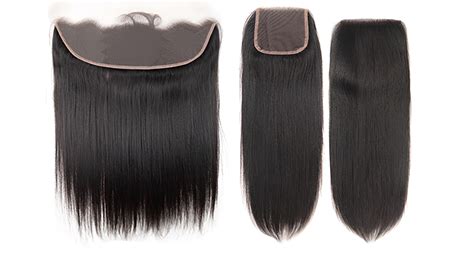Introduction
In the realm of hair extensions, two prominent methods stand apart: closure and frontal. While both offer distinct solutions for enhancing hair volume and versatility, understanding their key differences is crucial for making an informed decision. This comprehensive comparison delves into the intricacies of closure vs. frontal, empowering you with the knowledge to choose the technique that best suits your unique hair goals.

Understanding Closure Extensions (2×2/4×4/6×6)
Closure extensions are small, crescent-shaped hairpieces that cover a specific area on the scalp, typically the crown or the top of the head. They are designed to blend seamlessly with existing hair, creating the illusion of natural growth. Closures come in various sizes, the most common being 2×2, 4×4, and 6×6 inches.
Benefits of Closure Extensions
- Versatile: Closures allow for creative styling options such as buns, ponytails, and updos, as they expose a small portion of the natural scalp.
- Customizable: Closures can be colored and cut to match the exact texture and shade of your hair, ensuring an undetectable blend.
- Low-maintenance: Closures require minimal upkeep compared to frontals, making them a time-saving solution.
Drawbacks of Closure Extensions
- Limited coverage: Closures only cover a specific area of the scalp, which may not be sufficient for those with extensive hair loss or thinning.
- Can be visible: If not installed correctly or properly blended, closures can appear unnatural, creating a noticeable line of demarcation.
- Less protective: Closures leave a portion of the scalp exposed, offering less protection from UV rays and environmental factors.
Exploring Frontal Extensions (13×4/13×6/360)
Frontal extensions are larger, lace-based hairpieces that extend from ear to ear across the front of the head. They create a full, natural-looking hairline that resembles your own. Frontals come in various sizes, including 13×4, 13×6, and 360-degree installations.
Benefits of Frontal Extensions
- Complete coverage: Frontals provide maximum coverage, effectively concealing any areas of hair loss or thinning.
- Natural appearance: The lace base of frontals seamlessly blends with the scalp, creating an undetectable transition from hairpiece to natural hair.
- Styling versatility: Frontals offer the most styling freedom, allowing for a wide range of hairstyles, including high ponytails, braids, and cornrows.
Drawbacks of Frontal Extensions
- High-maintenance: Frontals require regular care and attention, including daily brushing, conditioning, and maintenance appointments.
- Costly: Frontals are typically more expensive than closures due to their larger size and advanced installation techniques.
- Can be uncomfortable: The lace base of frontals can be itchy or irritating for some individuals.
Comparison of Closure vs. Frontal Extensions
| Feature | Closure | Frontal |
|---|---|---|
| Coverage | Limited | Complete |
| Versatility | Moderate | High |
| Maintenance | Low | High |
| Cost | Affordable | Expensive |
| Comfort | Moderate | Variable |
Deciding Between Closure and Frontal Extensions
The decision between closure and frontal extensions depends on your individual needs and preferences. For those seeking a versatile, quick-to-install solution with limited coverage, closures are ideal. However, if complete coverage and maximum styling flexibility are your priorities, frontals are the better choice.
Step-by-Step Installation Process
Closure Installation:
- Section off a square or rectangular area on the scalp.
- Cut a piece of closure to fit the section.
- Apply adhesive to the closure and press it into place.
- Blend the hair around the closure to conceal the seam.
Frontal Installation:
- Measure and cut the frontal to fit your head size.
- Install the frontal using the lace-cutting technique or glue-in method.
- Blend the frontal with your natural hair using concealer or powder.
- Style your hair as desired.
Market Insights and Consumer Demand
According to market research by Forbes, the global hair extension market is projected to reach a staggering $12 billion by 2028. This growth is driven by increasing demand from both men and Gen-Z consumers, who are embracing hair extensions for a variety of reasons.
Innovative Applications and Ideas
“Blendini”: A hybrid technique that combines closure and frontal extensions for the ultimate balance of coverage, versatility, and comfort.
“Lace-Front Weave”: A method that involves attaching a lace frontal to a cornrowed base, creating a seamless transition and increased durability.
Conclusion
Closure and frontal extensions offer unique advantages and disadvantages, catering to different needs and preferences. Understanding the key differences between these techniques allows you to make an informed decision that aligns with your hair goals. By carefully evaluating the factors discussed in this comprehensive comparison, you can choose the extension method that empowers you to achieve the confidence and style you deserve.
